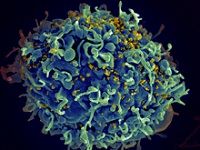 |
| HIV particles infecting a human T cell--Courtesy of NIAID/NIH |
Since the discovery of the AIDS virus in 1983, only one person is believed to have been completely cured of HIV--called the "Berlin patient." The case of Timothy Ray Brown has raised more questions than answers in the quest to eradicate the immune-compromising disease.
Brown had HIV for 11 years and had been taking antiretroviral drugs for treatment when he was diagnosed with acute myeloid leukemia in 2006. After receiving radiation therapy and a bone-marrow transplant from a donor with a specific genetic mutation, Brown went off antiretrovirals in 2009 and his HIV levels plummeted. Doctors consider the virus eradicated from his system.
Now, a new study, published in PLOS Pathogens, sheds light on three different factors that may have contributed to Brown's miraculous recovery.
The first is that radiation killed all or many of the viral reservoir cells--those that contain inactive or dormant cells infected with HIV--that were not eliminated by antiretroviral drugs. A second possibility is that a genetic mutation in the donor's cells that abolishes the function of the CCR5 gene protected Brown's cells from HIV infection. The CCR5 gene codes for a protein that allows HIV to enter human cells called CD4-T cells and infect them. Thus, the mutation protects against HIV infection. Yet another theory is that a "graft-versus-host" reaction occurred, where the transplanted cells recognized the HIV-infected cells as foreign and attacked and eliminated HIV-positive reservoir cells that survived Brown's radiation treatment.
To determine which of these may have contributed to HIV elimination in Brown, scientists at Emory University in Atlanta used a monkey model of Simian Immunodeficiency Virus, or SIV--a close relative of HIV that infects primates and causes a disease similar to AIDS--to replicate the same treatment that Brown had.
In a study of 6 monkeys infected with SIV, a test group of three animals was treated with antiretroviral therapy to mimic the typical treatment course in humans. The monkeys then underwent radiation therapy and received a transplant of bone marrow cells that had been harvested from the animals before they were infected with SIV.
The radiation killed most of the monkeys' existing blood and immune cells, including between 94% and 99% of their CD4-T cells--the main target of HIV infection. This was a sign that radiation may have helped to cure Brown.
Within three to 6 weeks after the treatments, the monkeys began to regenerate blood and immune cells, which signaled that the bone marrow transplant had been successful. Since the transplanted cells were not from a different donor, no graft-versus-host disease occurred.
After stopping the antiretroviral drugs, HIV rebounded in the monkeys, as predicted. The findings indicate that radiation may be able to reduce HIV levels, but it's not enough to eliminate all reservoirs of the virus, the researchers said. In the case of the Berlin patient, the researchers suggest that either the CCR5 deletion mutation in the donor or the presence of graft-versus-host disease played a significant role in eradicating HIV.
- read the study in PLOS Pathogens